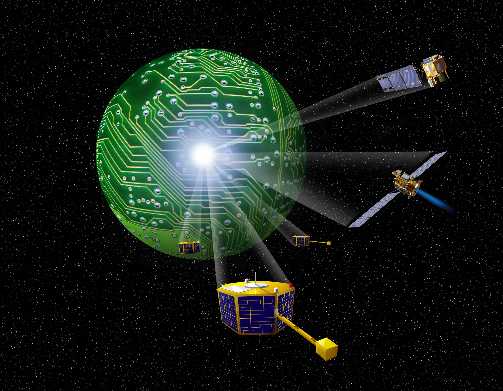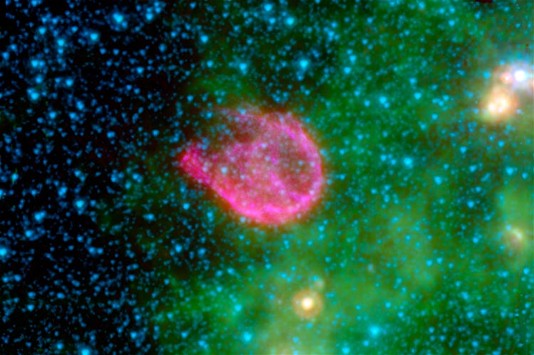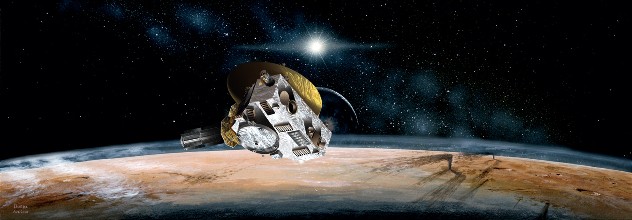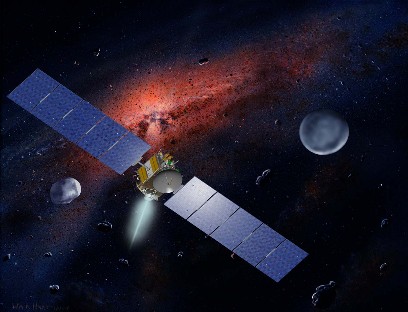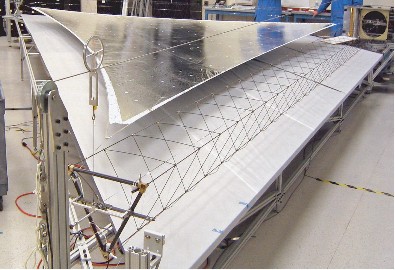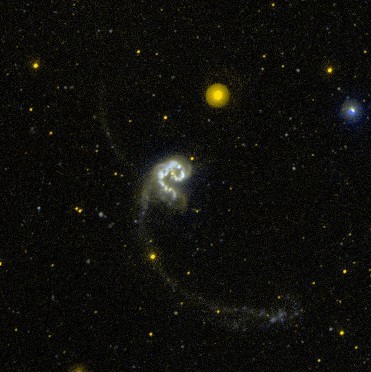Ultraviolet Surprise
by Patrick L. Barry and Tony Phillips
How would you like to visit a universe full of exotic stars and weird galaxies the likes of which astronomers on Earth have never seen before?
Now you can. Just point your web browser to http://galex.stsci.edu/GR2/ and start exploring.
That's the address of the Galaxy Evolution Explorer image archive, a survey of the whole sky at ultraviolet wavelengths that can't be seen from the ground. Earth's atmosphere blocks far-ultraviolet light, so the only way to see the ultraviolet sky is by using a space telescope such as NASAís Galaxy Evolution Explorer.
About 65% of the images from the all-sky survey haven't been closely examined by astronomers yet, so there are plenty of surprises waiting to be uncovered.
"The Galaxy Evolution Explorer produces so much data that, beyond basic quality control, we just don't have time to look at it all," says Mark Seibert, an astronomy postdoc at the Observatories of the Carnegie Institution of Washington in Pasadena, California.
This fresh view of the sky has already revealed striking and unexpected features of familiar celestial objects. Mira is a good example. Occasionally visible to the naked eye, Mira is a pulsating star monitored carefully by astronomers for more than 400 years. Yet until Galaxy Evolution Explorer recently examined Mira, no one would have guessed its secret: Mira possesses a comet-like tail 13 light-years long.
"Mira shows us that even well-observed stars can surprise us if we look at them in a different way and at different frequencies," Seibert says.
Another example: In April, scientists announced that galaxies such as NGC 1512 have giant ultraviolet spiral arms extending three times farther out into space than the arms that can be seen by visible-light telescopes. It would be like looking at your pet dog through an ultraviolet telescope and discovering his ears are really three times longer than you thought!
The images from the ultraviolet space telescope are ideal for hunting new phenomena. The telescope's small, 20-inch primary mirror (not much bigger than a typical backyard telescope) offers a wide field of view. Each image covers 1.2 degrees of sky - lots of territory for the unexpected.
If someone combing the archives does find something of interest, Seibert advises that she or he should first search astronomy journals to see whether the phenomenon has been observed before. If it hasn't, email a member of the Galaxy Evolution Explorer science team and let them know, Seibert says.
So what are you waiting for? Fire up your web browser and let the discoveries begin!
This article was provided by the Jet Propulsion Laboratory, California Institute of Technology, under a contract with the National Aeronautics and Space Administration.
Caption: Astronomers looking at new ultraviolet images from the Galaxy Evolution Explorer spacecraft were surprised to discover a 13-light-year long tail on Mira, a star that has been extensively studied for 400 years.
Going My Way?
by Diane K. Fisher
Not many endeavors require that you plan the mode of transportation before you even know what it is you are transporting. But weighing the physics and economics of getting any sort of cargo to space is a major part of designing a space mission.
Itís one of the first issues that NASAís New Millennium Program (NMP) considers when planning a new mission. NMP has the forward-looking job to identify promising new technologies for space exploration. It then helps to mature the technology so it will be available to space missions of the future. If the technology cannot be tested adequately on Earth, the last part of this process is to actually send the technology into space. With carefully documented test results, future mission planners can confidently incorporate the new technology into their designs.
But where to begin? On call from the start, Linda Herrell is the New Millennium Program Architect. Given a list of proposed technologies, she has the job of figuring out the feasibility of wrapping a mission around them.
"We might be considering six or more technologies, anything from solar panels to imagers to masts for solar sails to more intelligent software. Of those, we may choose four. My job is to answer the question - can the selected technology be transported to and operated in space within the constraints of a low-cost technology validation project?"
Along with the list of possible mission payloads (the technologies), Linda also has a list of spacecraft to put them on, as well as a list of launch vehicle parameters. All she has to do is try them out in every possible combination (of which there are thousands) and see what might work.
"Fortunately, we have a software tool to help with this analysis," says Linda. When it comes down to it, her job is primarily to figure out how to get the technologies into space.
"Sometimes, itís like figuring out how to get across town when you donít have your own car. You have to get creative."
She keeps a database of all possible options, including riding piggyback on another spacecraft, hitching a ride on a launch vehicle as a secondary payload, or sharing a launch vehicle with other NASA, Department of Defense, or even commercial payloads.
Her assessment is but one of a gazillion factors to be considered in planning a mission, but it is indeed one of the very first "details" that forms the foundation for the rest of the mission.
Find out some of the technologies that NMP has already validated or is considering at http://nmp.nasa.gov/TECHNOLOGY/innovative-tech.html
Kids will enjoy watching Lindaís cartoon alter-ego talk about her job at http://spaceplace.nasa.gov/en/kids/live
This article was provided by the Jet Propulsion Laboratory, California Institute of Technology, under a contract with the National Aeronautics and Space Administration.
Caption: NASAís New Millennium Program selects breakthrough technologies that will be of the greatest use to future space and Earth science missions and that are perceived to be risky to the first user.
The Red (Hot?) Planet
by Patrick L. Barry
Don't let Mars's cold, quiet demeanor fool you. For much of its history, the Red Planet has been a fiery world.
Dozens of volcanoes that dot the planet's surface stand as monuments to the eruptions that once reddened Mars's skies with plumes of glowing lava. But the planet has settled down in its old age, and these volcanoes have been dormant for hundreds of millions of years.
Or have they? Some evidence indicates that lava may have flowed on Mars much more recently. Images of the Martian surface taken by orbiting probes show regions of solidified lava with surprisingly few impact craters, suggesting that the volcanic rock is perhaps only a million years old.
If so, could molten lava still occasionally flow on the surface of Mars today?
With the help of some artificial intelligence software, a heat-sensing instrument currently orbiting Mars aboard NASA's Mars Odyssey spacecraft could be just the tool for finding active lava flows.
"Discovering such flows would be a phenomenally exciting scientific finding," says Steve Chien, supervisor of the Artificial Intelligence Group at JPL. For example, volcanic activity could provide a source of heat, thus making it more likely that Martian microbes might be living in the frosty soil.
The instrument, called THEMIS (for Thermal Emission Imaging System), can "see" the heat emissions of the Martian surface in high resolution - each pixel in a THEMIS image represents only 100 meters on the ground. But THEMIS produces about five times more data than it can transmit back to Earth.
Scientists usually know ahead of time which THEMIS data they want to keep, but they can't plan ahead for unexpected events like lava flows. So Chien and his colleagues are customizing artificial intelligence software called ScienceCraft to empower THEMIS to identify important data on its own.
This decision-making ability of the ScienceCraft software was first tested in Earth orbit aboard a satellite called Earth Observing-1 by NASA's New Millennium Program. Earth Observing-1 had already completed its primary mission, and the ScienceCraft experiment was part of the New Millennium Programís Space Technology 6 mission.
On Odyssey, ScienceCraft will look for anomalous hotspots on the cold, night side of Mars and flag that data as important. "Then the satellite can look at it more closely on the next orbit," Chien explains.
Finding lava is considered a long shot, but since THEMIS is on all the time, "it makes sense to look," Chien says. Or better yet, have ScienceCraft look for you - itís the intelligent thing to do.
To learn more about the Autonomous ScienceCraft software and see an animation of how it works, visit http://ase.jpl.nasa.gov
This article was provided by the Jet Propulsion Laboratory, California Institute of Technology, under a contract with the National Aeronautics and Space Administration.
Caption: Just as changing cloud patterns on Earth were identified using Earth Observing-1ís Advanced Land Imager along with ScienceCraft software, the THEMIS instrument with ScienceCraft on the Mars Odyssey spacecraft can avoid transmitting useless images.
A Missile In Your Eye
by Patrick L. Barry
Satellite technology designed to catch ballistic missile launches may soon help doctors monitor the health of people's eyes.
For the last 15 years, Greg Bearman and his colleagues at JPL have been working on a novel design for a spectrometer, a special kind of camera often used on satellites and spacecraft. Rather than snapping a simple picture, spectrometers measure the spectrum of wavelengths in the light coming from a scene. From that information, scientists can learn things about the physical properties of objects in the photo, be they stars or distant planets or vegetation on Earth's surface.
In this case, however, the challenge was to capture snapshots of short-lived events - like missile launches! The team of JPL scientists designed the new spectrometer, called a computed tomographic imaging spectrometer (CTIS), in collaboration with the Ballistic Missile Defense Organization as a way to detect missiles by the spectral signatures of their exhaust.
But now the scientists are pointing CTIS at another fast-moving scene: the retina of an eye.
Blood flowing through the retina has a different spectral signature when it is rich in oxygen than when it is oxygen deprived. So eye doctors can use a spectrometer to look for low oxygen in the retina: an indicator of disease. However, because the eye is constantly moving, images produced by conventional spectrometers would have motion blurring that is difficult to correct.
The spectrometer that Bearman helped to develop is different: It can capture the whole retina and its spectral information in a single snapshot as quick as 3 milliseconds. "We needed something fast," says Bearman, and this spectrometer is "missile-quick."
CTIS is even relatively cheap to build, consisting of standard camera lenses and a custom, etched, transparent sheet called a grating. "With the exception of the grating, we bought everything on Amazon," he says.
The grating was custom-designed at JPL. It has a pattern of microscopic steps on its surface that split incoming light into 25 separate images arranged in a 5 by 5 grid. The center image in the grid shows the scene undistorted, but colors in the surrounding images are slightly "smeared" apart, as if the light had passed through a prism. This separation of colors reveals the light's spectrum for each pixel in the image.
"We're conducting clinical trials now," says Bearman. If all goes well, anti-missile technology may soon be catching eye problems before they have a chance to get off the ground.
Information about other NASA-developed technologies with spin-off applications can be found at http://www.sti.nasa.gov/tto
This article was provided by the Jet Propulsion Laboratory, California Institute of Technology, under a contract with the National Aeronautics and Space Administration.
Caption: This three-color composite image from the computed tomographic imaging spectrometer shows the oxygenation of the blood in the arteries and veins of a human retina. (Arteries appear red, veins appear yellow).
Cosmic Cockroaches
By Dr. Tony Phillips
Cockroaches are supposed to be tough, able to survive anything from a good stomping to a nuclear blast. But roaches are wimps compared to a little molecule that has recently caught the eye of biologists and astronomers - the polycyclic aromatic hydrocarbon.
Polycyclic aromatic hydrocarbons (PAHs for short) are ring-shaped molecules made of carbon and hydrogen. "Theyíre all around us," says Achim Tappe of the Harvard Center for Astrophysics. "PAHs are present in mineral oils, coal, tar, tobacco smoke and automobile exhaust." Aromatic, ring-shaped molecules structurally akin to PAHs are found in DNA itself!
Thatís why Tappeís recent discovery may be so important. "PAHs are so tough, they can survive a supernova."
The story begins a few thousand years ago when a massive star in the Large Magellanic Cloud exploded, blasting nearby star systems and interstellar clouds with hot gas and deadly radiation. The expanding shell, still visible from Earth after all these years and catalogued by astronomers as "N132D," spans 80 light years and has swept up some 600 Suns worth of mass.
Last year "we observed N132D using NASAís Spitzer Space Telescope," says Tappe. Spitzer is an infrared (IR) telescope, and it has a spectrometer onboard sensitive to the IR emissions of PAHs. One look at N132D revealed "PAHs all around the supernovaís expanding shell. They appear to be swept up by a shock wave of 8 million degree gas. This is causing some damage to the molecules, but many of the PAHs are surviving."
Astronomers have long known that PAHs are abundant not only on Earth but throughout the cosmos - theyíve been found in comet dust, meteorites and many cold interstellar clouds - but who knew they were so tough? "This is our first evidence that PAHs can withstand a supernova blast," he says.
Their ability to survive may be key to life on Earth. Many astronomers are convinced that a supernova exploded in our corner of the galaxy 4-to-5 billion years ago just as the solar system was coalescing from primitive interstellar gas. In one scenario of lifeís origins, PAHs survived and made their way to our planet. It turns out that stacks of PAHs can form in water - think, primordial seas - and provide a scaffold for nucleic acids with architectural properties akin to RNA and DNA. PAHs may be just tough enough for genesis.
Cockroaches, eat your hearts out.
Find out about other Spitzer discoveries at http://www.spitzer.caltech.edu
This article was provided by the Jet Propulsion Laboratory, California Institute of Technology, under a contract with the National Aeronautics and Space Administration.
Caption: Using the IR spectrometer on the Spitzer Space Telescope, scientists found organic molecules in supernova remnant N132D.
Omit Needless Bytes!
by Patrick Barry and Tony Phillips
Now is an exciting time for space enthusiasts. In the history of the Space Age, there have never been so many missions "out there" at once. NASA has, for example, robots on Mars, satellites orbiting Mars, a spacecraft circling Saturn, probes en route to Pluto and Mercury - and four spacecraft, the two Voyagers and the two Pioneers, are exiting the solar system altogether.
Itís wonderful, but it is also creating a challenge.
The Deep Space Network that NASA uses to communicate with distant probes is becoming overtaxed. Status reports and data transmissions are coming in from all over the solar system - and thereís only so much time to listen. Expanding the network would be expensive, so it would be nice if these probes could learn to communicate with greater brevity. But how?
Solving problems like this is why NASA created the New Millennium Program (NMP). The goal of NMP is to flight-test experimental hardware and software for future space missions. In 1998, for instance, NMP launched an experimental spacecraft called Deep Space 1 that carried a suite of new technologies, including a new kind of communication system known as Beacon Monitor.
The system leverages the fact that for most of a probe's long voyage to a distant planet or asteroid or comet, it's not doing very much. Thereís little to report. During that time, mission scientists usually only need to know whether the spacecraft is in good health.
"If you don't need to transmit a full data stream, if you only need some basic state information, then you can use a much simpler transmission system," notes Henry Hotz, an engineer at NASA's Jet Propulsion Laboratory who worked on Beacon Monitor for Deep Space 1. So instead of beaming back complete data about the spacecraftís operation, Beacon Monitor uses sophisticated software in the probeís onboard computer to boil that data down to a single "diagnosis." It then uses a low-power antenna to transmit that diagnosis as one of four simple radio tones, signifying "all clear," "need some attention whenever you can," "need attention soon," or "I'm in big trouble - need attention right now!"
"These simple tones are much easier to detect from Earth than complex data streams, so the mission needs far less of the network's valuable time and bandwidth," says Hotz. After being tested on Deep Space 1, Beacon Monitor was approved for the New Horizons mission, currently on its way to Pluto, beaming back a simple beacon as it goes.
Discover more about Beacon Monitor technology, as well as other technologies, on the NMP Technology Validation Reports page, http://nmp-techval-reports.jpl.nasa.gov
This article was provided by the Jet Propulsion Laboratory, California Institute of Technology, under a contract with the National Aeronautics and Space Administration.
Caption: This artist's concept shows the New Horizons spacecraft during its planned encounter with Pluto and its moon, Charon. The spacecraft is currently using the Beacon Monitor system on its way to Pluto. Credit: Johns Hopkins University Applied Physics Laboratory/Southwest Research Institute (JHUAPL/SwRI)
Chew on This
The Mars robotic rovers, Spirit and Opportunity, are equipped with RATs, or Rock Abrasion Tools. Their purpose is to abrade the surface patina off the Mars rocks so that the alpha x-ray spectrometer can analyze the minerals inside the rocks, rather than just on the surface.
But future robotic missions to Mars will be asked to go even further below the surface. Scrapers and corers will gather rock samples of substantial size, that, in order to be analyzed by a spectrometer, will need to be crushed into a fine powder.
Crushing rocks on Mars? Now thereís a problem that brings to mind a multitude of possible approaches: Whack them with a large hammer? Squeeze them until they explode? How about just chewing them up? It was with this latter metaphor that the planetary instrument engineers struck pay dirt - so to speak.
Thanks to NASAís Planetary Instrument Definition and Development Program, a small group of NASA engineers came up with the Mars Rock Crusher. Only six inches tall, it can chew the hardest rocks into a powder.
The Mars Rock Crusher has two metal plates that work sort of like our jaws. One plate stays still, while the other plate moves. Rocks are dropped into the jaw between the two plates. As one plate moves in and out (like a lower jaw), rocks are crushed between the two plates. The jaw opening is larger toward the top and smaller towards the bottom. So when larger rocks are crushed near the top, the pieces fall down into the narrower part of the jaw, where they are crushed again. This process repeats until the rock particles are small enough to fall through a slit where the two plates are closest.
Engineers have tested the Mars Rock Crusher with Earth rocks similar to those expected to be found on Mars. One kind of rock is hematite. The rusted iron in hematite and other rocks help give Mars its nickname "The Red Planet." Another kind of rock is magnetite, so-called because it is magnetic. Rocks made by volcanoes are called basalts. Some of the volcanoes on Mars may have produced basalts with a lot of a mineral called olivine. We call those olivine basalts, and the Rock Crusher chews them up nicely too.
Visit http://www.jpl.nasa.gov/technology to read the latest about other NASA technologies for exploring other planets and improving life on this one.
This article was written by Diane K. Fisher and provided by the Jet Propulsion Laboratory, California Institute of Technology, under a contract with the National Aeronautics and Space Administration.
Caption: Looking down on the jaws of the Mars Rock Crusher, we see a magnetite rock get crushed into smaller and smaller particles.
The Ions of Dawn
By Patrick L. Barry
This summer, NASA will launch a probe bound for two unexplored worlds in our solar system's asteroid belt - giant asteroids Ceres and Vesta. The probe, called Dawn, will orbit first one body and then the other in a never-before-attempted maneuver.
It has never been attempted, in part, because this mission would be virtually impossible with conventional propulsion. "Even if we were just going to go to Vesta, we would need one of the largest rockets that the U.S. has to carry all that propellant," says Marc Rayman, Project System Engineer for Dawn at JPL. Traveling to both worlds in one mission would require an even bigger rocket.
This is a trip that calls for the unconventional. "Weíre using ion propulsion," says Rayman.
The ion engines for the Dawn spacecraft proved themselves aboard an earlier, experimental mission known as Deep Space 1 (DS1). Because ion propulsion is a relatively new technology thatís very different from conventional rockets, it was a perfect candidate for DS1, a part of NASA's New Millennium Program, which flight-tests new technologies so that missions such as Dawn can use those technologies reliably.
"The fact that those same engines are now making the Dawn mission possible shows that New Millennium accomplished what it set out to," Rayman says.
Ion engines work on a principle different from conventional rockets. A normal rocket engine burns a chemical fuel to produce thrust. An ion engine doesn't burn anything; a strong electric field in the engine propels charged atoms such as xenon to very high speed. The thrust produced is tiny - roughly equivalent to the weight of a piece of paper - but over time, it can generate as much speed as a conventional rocket while using only about 1/10 as much propellant.
And Dawn will need lots of propulsion. It must first climb into Vesta's orbit, which is tilted about 7 degrees from the plane of the solar system. After studying Vesta, it will have to escape its gravity and maneuver to insert itself in an orbit around Ceres - the first spacecraft to orbit two distant bodies. Dawn's up-close views of these worlds will help scientists understand the early solar system.
"They're remnants from the time the planets were being formed," Rayman says. "They have preserved a record of the conditions at the dawn of the solar system."
Find out about other New Millennium Program validated technologies and how they are being used in science missions at http://nmp.nasa.gov/TECHNOLOGY/infusion.html. While youíre there, you can also download "Professor Starrís Dream Trip," a storybook for grown-ups about how ion propulsion enabled a scientistís dream of visiting the asteroids come true. A simpler childrenís version is available at http://spaceplace.nasa.gov/en/kids/nmp/starr.
This article was provided by the Jet Propulsion Laboratory, California Institute of Technology, under a contract with the National Aeronautics and Space Administration.
Caption: Artistís rendering of Dawn spacecraft, with asteroids. Largest are Vesta and Ceres. Credits: Dawn spacecraft - Orbital Sciences Corporation; background art - William K. Hartmann, courtesy UCLA.
Clouds from Top to Bottom
By Patrick L. Barry
During the summer and fall of 2006, U.S. Coast Guard planes flew over the North Pacific in search of illegal, unlicensed, and unregulated fishing boats. It was a tricky operation - in part because low clouds often block the pilots' view of anything floating on the ocean surface below.
To assist in these efforts, they got a little help from the stars.
Actually, it was a satellite - CloudSat, an experimental NASA mission to study Earthís clouds in an entirely new way. While ordinary weather satellites see only the tops of clouds, CloudSatís radar penetrates clouds from top to bottom, measuring their vertical structure and extent. By tapping into CloudSat data processed at the Naval Research Laboratory (NRL) in Monterey, CA, Coast Guard pilots were better able to contend with low-lying clouds that might have otherwise hindered their search for illegal fishing activity.
In the past, Coast Guard pilots would fly out over the ocean not knowing what visibility to expect. Now they can find out quickly. Data from research satellites usually takes days to weeks to process into a usable form, but NASA makes CloudSat's data publicly available on its QuickLook website and to users such as NRL in only a matter of hours - making the data useful for practical applications.
"Before CloudSat, there was no way to measure cloud base from space worldwide," says Deborah Vane, project manager for CloudSat at NASA's Jet Propulsion Laboratory.
CloudSatís primary purpose is to better understand the critical role that clouds play in Earth's climate. But knowledge about the structure of clouds is useful not only for scientific research, but also to operational users such as Coast Guard patrol aircraft and Navy and commercial ships at sea.
"Especially when it's dark, thereís limited information about storms at sea," says Vane. "With CloudSat, we can sort out towering thunderclouds from blankets of calmer clouds. And we have the ability to distinguish between light rain and rain that is falling from severe storms." CloudSatís radar is much more sensitive to cloud structure than are radar systems operating at airports, and from its vantage point in space, Cloudsat builds up a view of almost the entire planet, not just one local area. "That gives you weather information that you don't have in any other way."
There is an archive of all data collected since the start of the mission in May 2006 on the CloudSat QuickLook website at http://cloudsat.atmos.colostate.edu And to introduce kids to the fun of observing the clouds, go to http://spaceplace.nasa.gov/en/kids/cloudsat_puz.shtml.
This article was provided by the Jet Propulsion Laboratory, California Institute of Technology, under a contract with the National Aeronautics and Space Administration.
Caption: A CloudSat ground track appears as a red line overlaid upon a GMS-6 (a Japanese weather satellite) infrared image. CloudSat is crossing the north-central Pacific Ocean on a descending orbit (from upper-right to lower-left) near a storm front. The radar data corresponding to this ground track (beginning in the center panel and continuing into the lower panel) shows a vertical cloud profile far more complex than the two-dimensional GMS-6 imagery would suggest. Thicker clouds and larger droplets are shown in yellow/red tones, while thinner clouds are shown in blue.
Early Bird Gets the Worm or "Black Hole Breakfast"
by Dr. Tony Phillips
We all know that birds eat worms. Every day, millions of birds eat millions of worms. Itís going on all around you! But how often have you awakened in the morning, stalked out in the dewy grass, and actually seen a bird having breakfast? Even though we know it happens all the time, a bird gulping a worm is a rare sight.
Just like a black hole gulping a star....
Every day in the Universe, millions of stars fall into millions of black holes. And thatís bad news for the stars. Black holes exert terrible tides, and stars that come too close are literally ripped apart as they fall into the gullet of the monster. A long burp of X-rays and ultraviolet radiation signals the meal for all to see.
Yet astronomers rarely catch a black hole in the act. "Itís like the problem of the bird and the worm," says astronomer Christopher Martin of Caltech. "You have to be in the right place at the right time, looking in the right direction and paying attention."
A great place to look is deep in the cores of galaxies. Most galaxies have massive black holes sitting in their pinwheel centers, with dense swarms of stars all around. An occasional meal is inevitable.
A group of astronomers led by Suvi Gezari of Caltech recently surveyed more than 10,000 galactic cores-and they caught one! In a distant, unnamed elliptical galaxy, a star fell into a central black hole and "burped" a blast of ultraviolet radiation.
"We detected the blast using the Galaxy Evolution Explorer (GALEX), an ultraviolet space telescope," explains Gezari. Her team reported the observation in the December 2006 issue of The Astrophysical Journal Letters. "Other telescopes have seen black holes devouring stars before," she adds, "but this is the first time we have been able to watch the process from beginning to end."
The meal began about two years ago. After the initial blast, radiation diminished as the black hole slowly consumed the star. GALEX has monitored the process throughout. Additional data from the Chandra X-ray Observatory, the Canada-France-Hawaii Telescope and the Keck Telescope in Hawaii helped Gezariís team chronicle the event in multiple wavelengths.
Studying the process in its entirety "helps us understand how black holes feed and grow in their host galaxies," notes Martin.
One down, millions to go.
"Now that we know we can observe these events with ultraviolet light," says Gezari, "we've got a new tool for finding more."
For more on this and other findings of GALEX, see http://www.galex.caltech.edu. For help explaining black holes to kids, visit The Space Place at http://spaceplace.nasa.gov.
This article was provided by the Jet Propulsion Laboratory, California Institute of Technology, under a contract with the National Aeronautics and Space Administration.
Caption: In this artistís concept, a giant black hole is caught devouring a star that ventured too closely.
Even Solar Sails Need a Mast
by Patrick L. Barry
Like the explorers of centuries past who set sail for new lands, humans may someday sail across deep space to visit other stars. Only it won't be wind pushing their sails, but the slight pressure of sunlight.
Solar sails, as they're called, hold great promise for providing propulsion in space without the need for heavy propellant. But building a solar sail will be hard; to make the most of sunlight's tiny push, the sail must be as large as several football fields, yet weigh next to nothing. Creating a super-lightweight material for the sail itself is tricky enough, but how do you build a "mast" for that sail that's equally light and strong?
Enter SAILMAST, a program to build and test-fly a mast light enough for future solar sails. With support from NASAís In-Space Propulsion Program to mature the technology and perform ground demonstrator tests, SAILMASTís engineers were ready to produce a truss suitable for validation in space that's 40 meters (about 130 feet) long, yet weighs only 1.4 kilograms (about 3 pounds)!
In spite of its light weight, this truss is surprisingly rigid. "It's a revelation when people come in and actually play with one of the demo versions - itís like, whoa, this is really strong!" says Michael McEachen, principal investigator for SAILMAST at ATK Space Systems in Goleta, California.
SAILMAST will fly aboard NASA's Space Technology 8 (ST8) mission, scheduled to launch in February 2009. The mission is part of NASAís New Millennium Program, which flight tests cutting-edge technologies so that they can be used reliably for future space exploration. While actually flying to nearby stars is probably decades away, solar sails may come in handy close to home. Engineers are eyeing this technology for "solar sentinels," spacecraft that orbit the Sun to provide early warning of solar flares.
Once in space, ST8 will slowly deploy SAILMAST by uncoiling it. The truss consists of three very thin, 40-meter-long rods connected by short cross-members. The engineers used high-strength graphite for these structural members so that they could make them very thin and light.
The key question is how straight SAILMAST will be after it deploys in space. The smaller the curve of the mast the more load it can support. "That's really why we need to fly it in space, to see how straight it is when it's floating weightlessly," McEachen says.
Itís an important step toward building a sail for the space-mariners of the future.
Find out more about SAILMAST at http://nmp.nasa.gov/st8. Kids can visit http://spaceplace.nasa.gov/en/kids/st8/sailmast to see how SAILMAST is like a Slinkyģ toy in space.
This article was provided by the Jet Propulsion Laboratory, California Institute of Technology, under a contract with the National Aeronautics and Space Administration.
Caption: SAILMAST is the thin triangular truss in front of the picture. It is attached to a section of a silver foil solar sail section shown here in a laboratory test. The mast in the picture is 2m (6 ft) long. The Space Technology 8 mission will test the SAILMAST, which is 20 times longer.
A Great Big Wreck
by Dr. Tony Phillips
People worry about asteroids. Being hit by a space rock can really ruin your day. But thatís nothing. How would you like to be hit by a whole galaxy?
It could happen. Astronomers have long known that the Andromeda Galaxy is on a collision course with the Milky Way. In about 3 billion years, the two great star systems will crash together. Earth will be in the middle of the biggest wreck in our part of the Universe.
Astronomer John Hibbard isnít worried. "Galaxy collisions arenít so bad," he says. A typical spiral galaxy contains a hundred billion stars, yet when two such behemoths run into each other "very few stars collide. The stars are like pinpricks with lots of space between them. The chance of a direct hit, star vs. star, is very low."
Hibbard knows because he studies colliding galaxies, particularly a nearby pair called the Antennae. "The two galaxies of the Antennae system are about the same size and type as Andromeda and the Milky Way." He believes that the Antennae are giving us a preview of whatís going to happen to our own galaxy.
The Antennae get their name from two vast streamers of stars that resemble the feelers on top of an insectís head. These streamers, called "tidal tails," are created by gravitational forces - one galaxy pulling stars from the other. The tails appear to be scenes of incredible violence.
But looks can be deceiving: "Actually, the tails are quiet places," says Hibbard. "Theyíre the peaceful suburbs of the Antennae." He came to this conclusion using data from GALEX, an ultraviolet space telescope launched by NASA in 2003.
The true violence of colliding galaxies is star formation. While individual stars rarely collide, vast interstellar clouds of gas do smash together. These clouds collapse. Gravity pulls the infalling gas into denser knots until, finally, new stars are born. Young stars are difficult to be around. They emit intensely unpleasant radiation and tend to "go supernova."
GALEX can pinpoint hot young stars by the UV radiation they emit and, in combination with other data, measure the rate of star birth. "Surprisingly," Hibbard says, "star formation rates are low in the tidal tails, several times lower than what we experience here in the Milky Way." The merging cores of the Antennae, on the other hand, are sizzling with new stars, ready to explode.
So what should you do when your galaxy collides? A tip from GALEX: head for the tails.
To see more GALEX images, visit http://www.galex.caltech.edu. Kids can read about galaxies and how a telescope can be a time machine at http://spaceplace.nasa.gov/en/educators/galex_puzzles.pdf.
This article was provided by the Jet Propulsion Laboratory, California Institute of Technology, under a contract with the National Aeronautics and Space Administration.
Caption: This GALEX UV image of the colliding Antennae Galaxies shows areas of active star formation, which is not in the tidal tails as one might expect.


